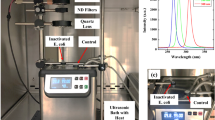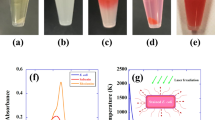Abstract
MANY biological materials, including bacteria, have been shown to be more readily damaged when oxygen is available to the cell at the time of irradiation than when it is absent1,2. Serratia marcescens shows this enhanced sensitivity to radiation—the so-called ‘oxygen effect’—almost to the full extent when a suspension of them is saturated with a gas mixture containing only 1 per cent oxygen and 99 per cent nitrogen, provided the radiation is given at normal dose-rates of about 1,000 rads/min. Typical inactivation curves for this organism using 1.5 MV. X-radiation from a pulsed linear accelerator are given in Fig. 1. Using the intense electron beam from the same linear accelerator, however, a dose of some 10–20 kilorads can be delivered in 2 microsec. The results quoted below indicate that when such large single pulses are used, the same bacteria saturated with the same oxygen–nitrogen mixture show the lower sensitivity corresponding to anaerobic irradiation. This is thought to be due to the fact that the first few kilorads of the electron pulse remove dissolved oxygen from the interior of the bacterium by radiation-induced reactions. During the remainder of the pulse the bacterium will thus be receiving radiation under essentially anærobic conditions. Even though dissolved molecular oxygen may not be entirely removed by the radiation from the extracellular liquid, this cannot penetrate the cell by diffusion in the 2 microsec. that the pulse lasts.
This is a preview of subscription content, access via your institution
Access options
Subscribe to this journal
Receive 51 print issues and online access
$199.00 per year
only $3.90 per issue
Buy this article
- Purchase on Springer Link
- Instant access to full article PDF
Prices may be subject to local taxes which are calculated during checkout
Similar content being viewed by others
References
Gray, L. H., “Organic Peroxides in Radiobiology”, 104 (Masson et Cie, Paris, 1958).
Gray, L. H., Chase, H. B., Deschner, E. E., Hunt, J. W., and Scott, O. C. A., Second United Nations Conference on Peaceful Uses of Atomic Energy Paper 15/P/293 (1958).
Boag, J. W., Dolphin, G. W., and Rotblat, J., Rad. Res., 9, 589 (1958).
Author information
Authors and Affiliations
Rights and permissions
About this article
Cite this article
DEWEY, D., BOAG, J. Modification of the Oxygen Effect when Bacteria are given Large Pulses of Radiation. Nature 183, 1450–1451 (1959). https://doi.org/10.1038/1831450a0
Issue Date:
DOI: https://doi.org/10.1038/1831450a0
This article is cited by
-
Possible mechanisms and simulation modeling of FLASH radiotherapy
Radiological Physics and Technology (2024)
-
The current status of FLASH particle therapy: a systematic review
Physical and Engineering Sciences in Medicine (2023)
-
Towards clinical translation of FLASH radiotherapy
Nature Reviews Clinical Oncology (2022)
-
Effect of High Dose Rates on Survival of Mammalian Cells
Nature (1967)
-
Modification of Radiation ‘Cerebral Death’ by Hypoxia
Nature (1965)
Comments
By submitting a comment you agree to abide by our Terms and Community Guidelines. If you find something abusive or that does not comply with our terms or guidelines please flag it as inappropriate.



